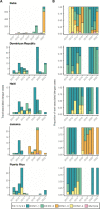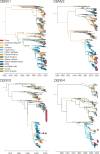This is a preprint.
Travel surveillance uncovers dengue virus dynamics and introductions in the Caribbean
- PMID: 37986857
- PMCID: PMC10659465
- DOI: 10.1101/2023.11.11.23298412
Travel surveillance uncovers dengue virus dynamics and introductions in the Caribbean
Update in
-
Travel surveillance uncovers dengue virus dynamics and introductions in the Caribbean.Nat Commun. 2024 Apr 25;15(1):3508. doi: 10.1038/s41467-024-47774-8. Nat Commun. 2024. PMID: 38664380 Free PMC article.
Abstract
Dengue is the most prevalent mosquito-borne viral disease in humans, and cases are continuing to rise globally. In particular, islands in the Caribbean have experienced more frequent outbreaks, and all four dengue virus (DENV) serotypes have been reported in the region, leading to hyperendemicity and increased rates of severe disease. However, there is significant variability regarding virus surveillance and reporting between islands, making it difficult to obtain an accurate understanding of the epidemiological patterns in the Caribbean. To investigate this, we used travel surveillance and genomic epidemiology to reconstruct outbreak dynamics, DENV serotype turnover, and patterns of spread within the region from 2009-2022. We uncovered two recent DENV-3 introductions from Asia, one of which resulted in a large outbreak in Cuba, which was previously under-reported. We also show that while outbreaks can be synchronized between islands, they are often caused by different serotypes. Our study highlights the importance of surveillance of infected travelers to provide a snapshot of local introductions and transmission in areas with limited local surveillance and suggests that the recent DENV-3 introductions may pose a major public health threat in the region.
Figures






References
-
- Kimberlin D. W., Barnett E., Lynfield R. & Sawyer M. H. Red Book 2021: Report of the Committee on Infectious Diseases. (American Academy of Pediatrics, 2021).
-
- Guzman M. G. & Harris E. Dengue. Lancet 385, 453–465 (2015). - PubMed
Publication types
Grants and funding
LinkOut - more resources
Full Text Sources
